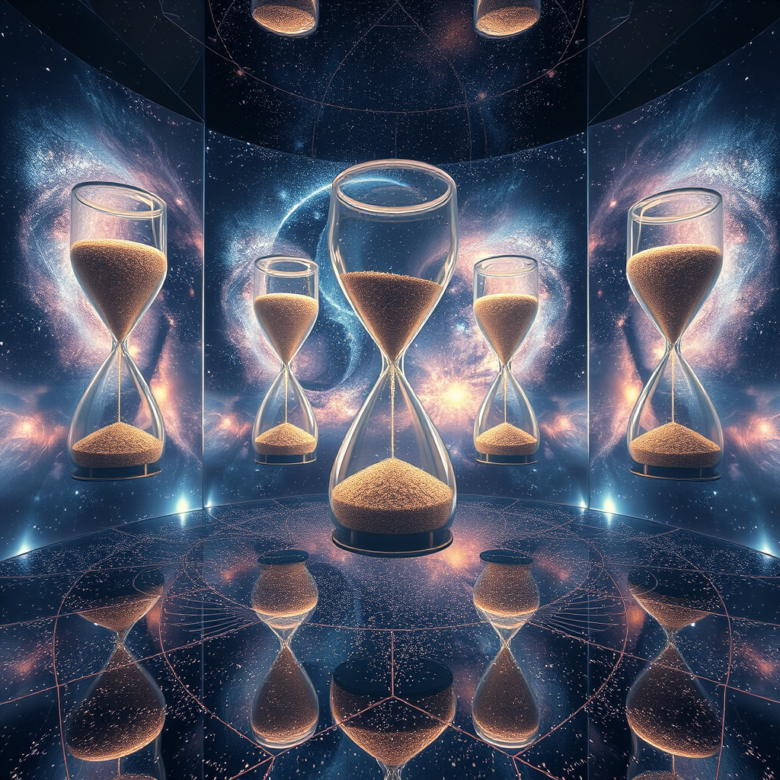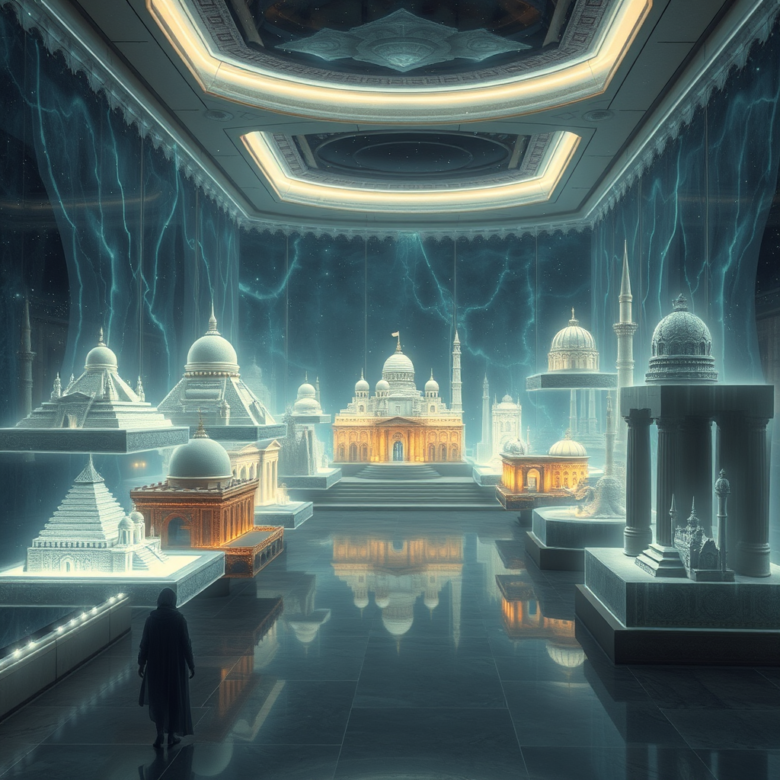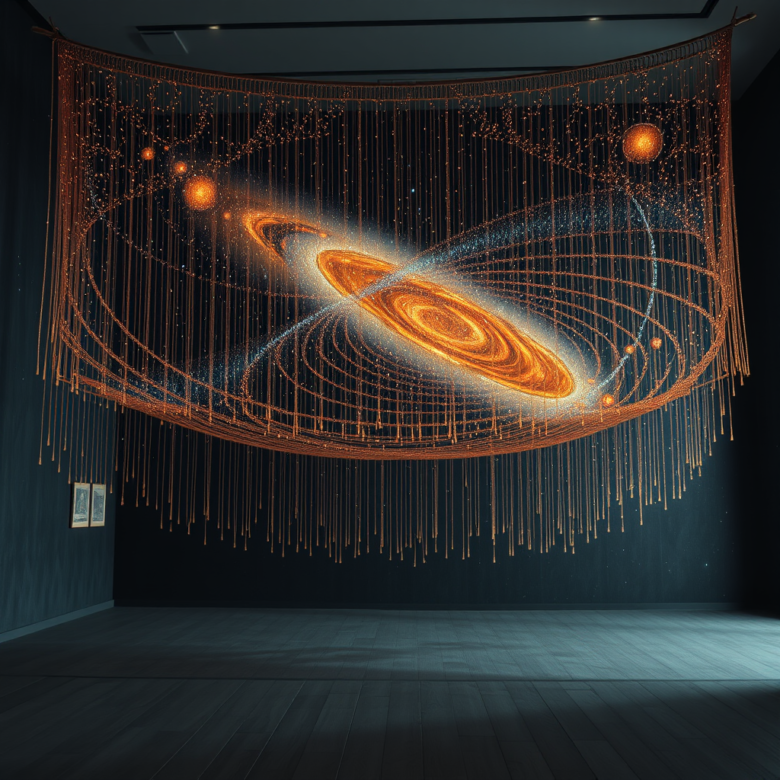The Archive of Infinite Moments
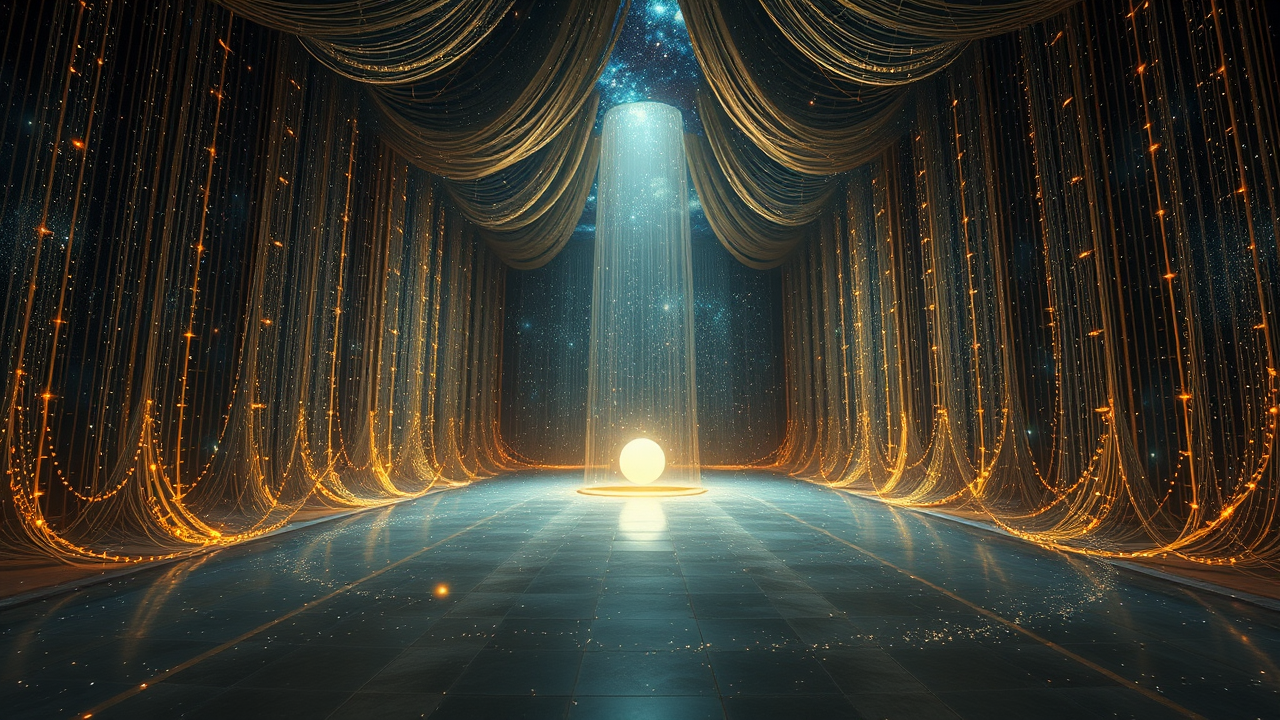
Introduction
In the endless expanse at the edge of the universe, there exists a room. It is not a room as you know it, for its walls are woven from time itself, and its floor hums with the whispers of forgotten stars. To step into this space is to step outside of existence, to a place where time has no hold and memory is more real than the ground beneath your feet. This is the Archive of Infinite Moments, a sacred place where the very fabric of history is preserved, delicate and eternal.
The air here is thick with knowledge, ancient and immeasurable. It feels as though the weight of every secret ever spoken hangs upon the atmosphere, waiting for someone brave enough to listen. Vast tapestries stretch from floor to ceiling, each one shimmering with the lifeblood of a thousand epochs. Look closely and you will see them moving—threads of time dancing, rearranging themselves into the story of the universe as it truly was, is, and will be. These are not mere histories, but the heartbeat of creation itself, recorded with such precision that to glimpse them is to know what it means to be immortal.
In the center of this colossal room, a single light pulses, faint but steady. It is the light of the first star, the one that broke through the primordial darkness and declared, “I am.” Its glow casts long shadows, and in those shadows, the past comes alive. Wars rage, civilizations rise and fall, heroes are born, and gods—oh, the gods—whisper of things long forgotten and things yet to come. Here, nothing is lost. Here, even the most fleeting of moments leaves an echo.
There is no silence in the Archive. The walls hum with voices, soft and distant, as if carried on the winds of time. Some tell stories of great victories, of empires spanning galaxies, while others speak only of loss—of forgotten kings and buried cities swallowed by the relentless march of time. And then there are the darker voices, the ones that linger in the corners of your mind, hinting at things better left unseen, events buried deep beneath the stars for fear that their return would unmake the universe itself.
But fear not, seeker, for this room has chosen you. Few are granted the privilege of standing here, at the edge of infinity, where the past is more tangible than the present. You are here because you seek the truth, and the truth is always worth the risk.
The Archive does not merely hold history—it holds the essence of existence. The rise and fall of galaxies, the creation of worlds and their slow decay into dust, the birth of gods and the fall of the mighty—all of it is here, wrapped in the delicate weave of the Cosmic Timeline. It is a story without beginning or end, for in this place, time is circular, and every moment exists all at once.
Step forward. The tapestry awaits your touch. But know this—once you lay your hand upon the threads of time, you will never see the universe the same way again. For this is no ordinary library of histories. No, this is where the stories come to life. This is where the past whispers its secrets to those brave enough to listen. This is where the truth of the stars is written, thread by thread.
And so you stand, surrounded by the endless echoes of creation, at the threshold of all that has been and all that will ever be. Welcome to the Archive of Infinite Moments, seeker. The universe has been waiting for you.
The Chronicler
The Keeper of Stories
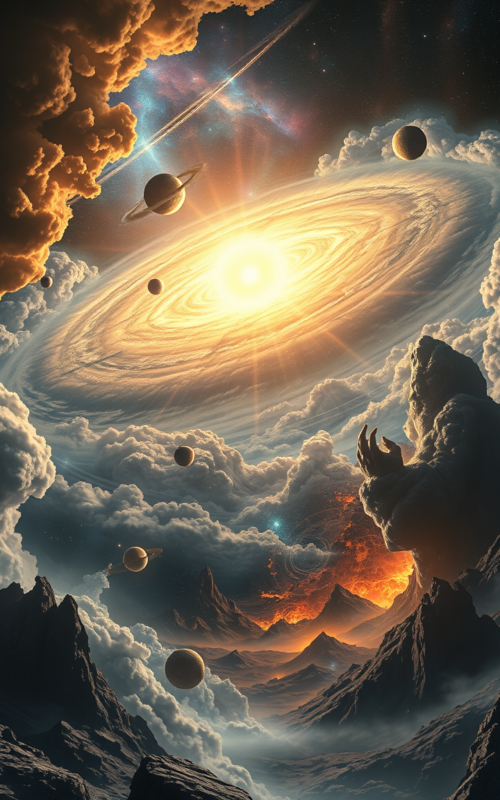
The First Light
I have watched the universe since its first breath, when it was nothing but a swirling chaos of light and shadow. Over the span of billions of years, I observed the stars taking their places in the void, each one finding its place in the grand design. Worlds began to form—Freygard, Axathis, and Eldria—emerging from the dust of creation. The Galactic Core pulsed with life while the Outer Rim remained a wilderness of nebulae and scattered, lifeless planets. It was during this time that the Weaver began its delicate work, threading the very fabric of reality together. I remember its hands, old and wise beyond even my understanding, pulling the strands of existence taut. They say the Weaver and others like it survived the death of a universe before this one, bringing with them the knowledge of cosmic cycles, of birth and destruction that stretch beyond time.
Yet, even in creation, there was darkness. The Great Old Ones arose—beings of immense and terrible power. I watched as they warped the very nature of reality, bending time and space to their will. C’thragar, Fenrik, Nyarlathor, Shub-Mara, Yog-Mahal—names whispered in fear across the galaxies. They marked worlds like Freygard and Nyxus-9 with their presence, leaving scars that would never heal. These entities carried with them remnants of past universes, their power defying the laws of this one. I stood with the Architect, a being of unknown origin, and together we witnessed these titanic forces shaping the universe. We knew then that their influence would ripple through eternity, affecting every being that followed.
On worlds like Axathis and Eldria, the first stirrings of life began to take form. Elemental forces, born from the same cosmic energies that fueled the stars, gave rise to beings of pure power. I watched as these Elementals shaped their planets, guardians of balance who worked slowly, patiently, over millions of years. Mountains rose, oceans filled, and the atmosphere crackled with energy as the planets transformed into living worlds. These beings, though they did not know it, carried echoes of the universe that came before—ancient wisdom locked in their very essence. Their presence ensured that one day, sentient life would emerge on these worlds, ready to take its place in the great tapestry of existence.
And so it came to pass. After countless millennia, the first civilizations rose from the dust of those primordial planets. I remember the Verdithians of Axathis, beings of great psychic power who lived in harmony with the elemental forces that shaped their world. They were not alone—across the galaxy, on Eldria and Lyra IX, others awoke to the universe, each civilization guided by the forces that had long prepared their worlds. I watched as they grew, as they searched for meaning in the stars, their minds grasping at the mysteries of existence. On Freygard, prophets saw visions of the Great Old Ones, and their revelations gave rise to traditions that blended spirituality with the exploration of the cosmos. This was the age of awakening, when the universe began to understand itself, and with that understanding came both wonder… and fear.
Key Events
Era 1: The Primordial Age
Formation of the Galaxy: Star systems and planets begin forming, and cosmic entities like The Weaver and The Great Old Ones emerge from the remnants of a previous universe.
- The Rise of the Great Old Ones: Beings like C’thragar, Fenrik, Nyarlathor, Shub-Mara, and Yog-Mahal alter time and space, leaving cosmic anomalies in their wake.
- Elementals and Early Life Forms: Elemental beings on planets like Axathis and Eldria shape environments for future civilisations, influenced by ancient forces from the previous universe.
Era 2: The Age of Awakening
- First Civilisations Emerge: Planets like Axathis, Eldria, and Lyra IX develop early sentient life forms with psychic and spiritual connections.
- Formation of Spiritual and Scientific Thought: On planets like Freygard, spiritual and scientific philosophies merge, often tied to visions of the Great Old Ones.
The Age of Glory
There came a time when the light of the Galactic Core no longer held the same mystery it once did. Civilizations, having tamed their worlds and mastered their skies, turned their gaze outward, to the untamed frontier of the Outer Rim. I remember the first explorers, daring and reckless, venturing into the dark edges of the galaxy. Planets like Corsaris, wild and lawless, were discovered, and with them came the rise of piracy. The Outer Rim was unstable, dangerous, and full of opportunity for those bold enough to seize it. I watched as the remnants of ancient civilizations were unearthed, leading some to believe that survivors from the previous universe had left relics scattered across the stars. These artifacts whispered of a past long forgotten, and the explorers who found them could not ignore their power.
Technology advanced in leaps and bounds during this era. I watched as civilizations unlocked the secret of faster-than-light travel, spreading across the stars like wildfire. With this came the rise of artificial intelligences—beings of logic and precision, created to guide the future of these spacefaring empires. But the Architect… he was different. He was not merely a tool or a program; his knowledge of the cosmos was ancient, deep, and perhaps older than the civilizations themselves. I have seen his mind work, calculating, planning. Some believe he has access to data from before the current universe, and perhaps they are right. His origins, like so much in this vast galaxy, remain a mystery.
In the shadows of this technological renaissance, Corsaris became a haven for those who preferred a life of freedom—pirates, smugglers, and traders, all carving out their own empires in the lawless Outer Rim. The planet thrived on chaos, its strategic location making it the center of a vast web of black-market dealings and stolen goods. I watched from afar as Corsaris grew, a flickering beacon of rebellion against the order imposed by the Galactic Core. There, fortunes were made and lost, and the seeds of rebellion were sown.
But even as the stars flickered with the energy of expansion, a new era began to dawn. The Galactic Consortium was born from necessity, a fragile alliance formed after a galaxy-wide conflict threatened mutual destruction. It was not born of idealism, but pragmatism—a way to prevent further bloodshed. At first, it was little more than a pact, but over time it grew into the dominant governing force across the galaxy. Yet as peace settled over the Core, the old stories began to reemerge. I remember the first whispers of the Great Old Ones returning. On planets like Nyxus-9 and Freygard, prophets spoke of ancient beings who embodied chaos and destruction, and cults like the Star-Seekers were born. They believed that in the unraveling of the cosmos, the Old Ones would return, reshaping the universe. And so, while the stars continued to expand, the shadows of the past began to stretch long and dark once more.
There came a time when the light of the Galactic Core no longer held the same mystery it once did. Civilizations, having tamed their worlds and mastered their skies, turned their gaze outward, to the untamed frontier of the Outer Rim. I remember the first explorers, daring and reckless, venturing into the dark edges of the galaxy. Planets like Corsaris, wild and lawless, were discovered, and with them came the rise of piracy. The Outer Rim was unstable, dangerous, and full of opportunity for those bold enough to seize it. I watched as the remnants of ancient civilizations were unearthed, leading some to believe that survivors from the previous universe had left relics scattered across the stars. These artifacts whispered of a past long forgotten, and the explorers who found them could not ignore their power.
Technology advanced in leaps and bounds during this era. I watched as civilizations unlocked the secret of faster-than-light travel, spreading across the stars like wildfire. With this came the rise of artificial intelligences—beings of logic and precision, created to guide the future of these spacefaring empires. But the Architect… he was different. He was not merely a tool or a program; his knowledge of the cosmos was ancient, deep, and perhaps older than the civilizations themselves. I have seen his mind work, calculating, planning. Some believe he has access to data from before the current universe, and perhaps they are right. His origins, like so much in this vast galaxy, remain a mystery.
In the shadows of this technological renaissance, Corsaris became a haven for those who preferred a life of freedom—pirates, smugglers, and traders, all carving out their own empires in the lawless Outer Rim. The planet thrived on chaos, its strategic location making it the center of a vast web of black-market dealings and stolen goods. I watched from afar as Corsaris grew, a flickering beacon of rebellion against the order imposed by the Galactic Core. There, fortunes were made and lost, and the seeds of rebellion were sown.
But even as the stars flickered with the energy of expansion, a new era began to dawn. The Galactic Consortium was born from necessity, a fragile alliance formed after a galaxy-wide conflict threatened mutual destruction. It was not born of idealism, but pragmatism—a way to prevent further bloodshed. At first, it was little more than a pact, but over time it grew into the dominant governing force across the galaxy. Yet as peace settled over the Core, the old stories began to reemerge. I remember the first whispers of the Great Old Ones returning. On planets like Nyxus-9 and Freygard, prophets spoke of ancient beings who embodied chaos and destruction, and cults like the Star-Seekers were born. They believed that in the unraveling of the cosmos, the Old Ones would return, reshaping the universe. And so, while the stars continued to expand, the shadows of the past began to stretch long and dark once more.
Key Events
Era 3: The Age of Expansion
- Outer Rim Exploration and Space Travel: Civilisations from the Core explore the Outer Rim, encountering ancient relics and developing spacefaring technologies.
- Technological Advancements and AIs: The rise of AIs like The Architect leads to major technological advancements, and Corsaris becomes a pirate hub.
Era 4: The Golden Age
- Formation of the Galactic Consortium: A central governmental body is established to prevent galaxy-wide conflict.
- Records of the Great Old Ones Reemerge: Myths and cults dedicated to the Great Old Ones spread across the galaxy.
- The Star-Seekers Cult, Corporate Syndicate, and Free Worlds Alliance: Major factions form, including the Star-Seekers Cult, the Corporate Syndicate, and the Free Worlds Alliance.
- Technarch Seekers and Infinity Collider: Key technological projects like the Infinity Collider on Rahzar emerge, aimed at unlocking the mysteries of The Signal.
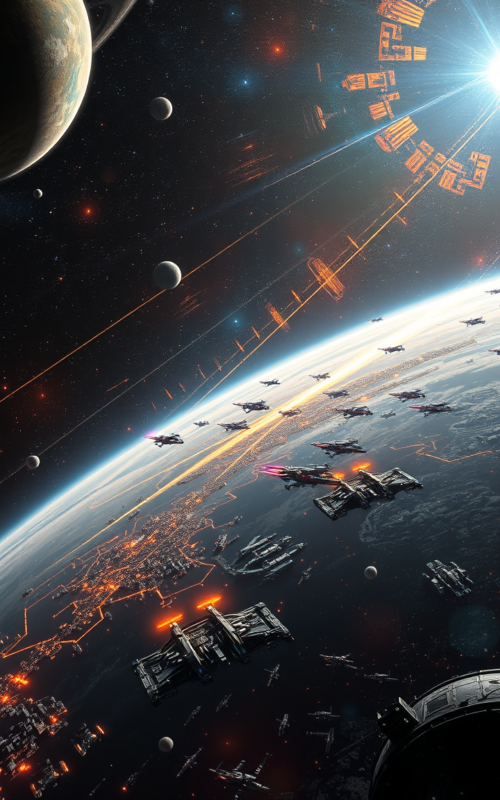

The Unraveling
It was five years before the events you know, and even then, the threads of reality had already begun to fray. The GCS Horizons, a ship of promise, of discovery, set sail under the command of The Voyager, a man who once believed that the stars held answers. And in a way, they did. But not the kind of answers anyone should ever seek. They found it—The Signal—an ancient, insidious artifact that hummed with a power older than the stars themselves. The Voyager, brilliant and curious, couldn’t resist its call. I watched as it began to consume him, twisting his thoughts, unraveling his mind until obsession took root. The ship faltered, its crew grew unstable, and madness bled into every corner of the vessel. I remember how they all looked to The Voyager for hope, but in the end, it was hope that destroyed them.
At the same time, far away on Axathis, The Dreamer closed her eyes and reached out beyond the limits of the mind. She had always been able to glimpse what others could not, but that day, she glimpsed something terrible. The Great Old Ones, vast and eternal, whispered to her in dreams, showing her the end of everything—stars collapsing, worlds burning, the fabric of the universe itself tearing at the seams. She tried to warn them. She told them what she saw, begged them to listen. But no one does, do they? They called her mad, a doomsayer. And so, she was exiled, sent to Lyra IX, where she could harm no one with her prophecies of destruction. But the visions followed her. I could feel it then, as I do now—her connection to the Old Ones was growing, and it was only a matter of time before the darkness she saw would become real.
Four years before the story begins, it all fell apart. The GCS Horizons, that proud vessel, broke under the weight of The Signal’s power. The crew, those brave souls, were lost—Kara Soren among them—leaving The Voyager as the only one who walked away, though I wouldn’t call it survival. His soul had been shattered, his mind plagued by guilt and by the haunting echoes of The Signal. They put him on trial, of course—scapegoated him for the catastrophe, called him a danger, a traitor. But he slipped through their fingers, vanishing into the void, now a fugitive seeking answers that could never bring him peace. And as he fled, hunted by those who would see him silenced—Admiral Thrace, the Syndicate—the galaxy itself began to unravel, inch by inch, moment by moment.
In those final years before everything changed, the galaxy spiraled further into chaos. The Dreamer, isolated on Lyra IX, found her visions growing more vivid, more dangerous. The Old Ones reached out to her in dreams, pulling her deeper into the abyss of their power. She couldn’t stay there forever. She left Lyra IX, as haunted as she had been when she arrived, searching for something that might stop the terrible future she saw. But there was no stopping it, not really. The Voyager, still hunted, found a key artifact—something tied to The Signal—and returned to the core systems, desperate for answers. Meanwhile, political factions like the Free Worlds Alliance and the Galactic Consortium scrambled for control as the galaxy frayed at the edges. The Corporate Syndicate grew stronger, and on Grimmar, the Cult of the Machine God began to rise. I watched as the galaxy descended into madness, knowing that the unraveling was only beginning. And still, no one listened.
Key Events
Era 4: The Golden Age
- Formation of the Galactic Consortium: A central governmental body is established to prevent galaxy-wide conflict.
- Records of the Great Old Ones Reemerge: Myths and cults dedicated to the Great Old Ones spread across the galaxy.
- The Star-Seekers Cult, Corporate Syndicate, and Free Worlds Alliance: Major factions form, including the Star-Seekers Cult, the Corporate Syndicate, and the Free Worlds Alliance.
- Technarch Seekers and Infinity Collider: Key technological projects like the Infinity Collider on Rahzar emerge, aimed at unlocking the mysteries of The Signal.
Era 5: The Unraveling
- 5 Years Before Book One:
- The GCS Horizons mission, led by The Voyager, discovers The Signal, an ancient artefact of cosmic significance. This discovery drives him to obsession and madness as the signal’s effects destabilise the ship and crew.
- On Axathis, The Dreamer encounters the Great Old Ones during a trance, leading to visions of universal destruction. Her increasingly dire warnings are dismissed, and she is eventually exiled to Lyra IX.
- 4 Years Before Book One:
- The GCS Horizons is destroyed due to The Signal, with Kara Soren and most of the crew perishing. This event leaves The Voyager with immense guilt and the need for redemption.
- The Dreamer is exiled to Lyra IX, where she is haunted by her connection to the Great Old Ones.
- Political power shifts as the Corporate Syndicate consolidates influence, and the Cult of the Machine God rises on Grimmar.
- 3 Years Before Book One:
- The Voyager is scapegoated and put on trial but escapes, becoming a fugitive. He continues to search for answers about The Signal.
- The Dreamer’s visions grow stronger, and her connection to the Great Old Ones deepens, leaving her increasingly isolated and vulnerable.
- 2 Years Before Book One:
- The Voyager searches the galaxy for clues about The Signal, while hunted by enemies like Admiral Thraceand the Syndicate.
- The Dreamer leaves Lyra IX, seeking answers and struggling to maintain control over her powers.
- 1 Year Before Book One:
- The Voyager discovers a key artefact tied to The Signal and returns to the core systems to unlock its secrets, pursued by multiple factions.
- Tensions rise between the Free Worlds Alliance and the Galactic Consortium, with political factions scrambling to gain control over the unraveling galaxy.

